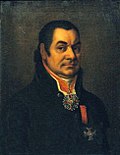Историко-краеведческий музей г.Таганрога (дворец Н.Д.Алфераки) | |
 | |
 | |
| Established | 1848, 1927 (as a museum) |
|---|---|
| Location | Ulitsa Frunze 41, Taganrog |
| Coordinates | 47°12′48″N38°55′41″E / 47.21333°N 38.92806°E |
| Type | Museum of local history |
| Director | Galina Alexandrovna Krupnitskaya (Russian: Галина Александровна Крупницкая) |
| Public transit access | "Museum of Local Lore and History" Tram Stop |
Alferaki Palace is a museum in Taganrog, Russia, originally the home of the wealthy merchant Nikolay Alferaki. It was built in 1848 by the architect Andrei Stackenschneider on Frunze Street (formerly Katolicheskaya), in downtown Taganrog.















